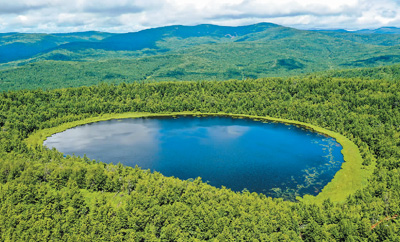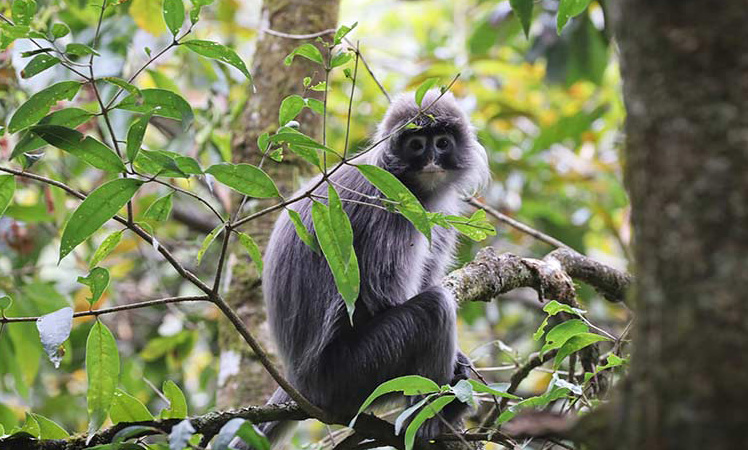China makes huge strides over past decade in major effort to boost afforestation
Thanks to China’s long-term afforestation efforts, 960 million mu (64 million hectares) of trees have been planted in the country over the past decade. The country’s forest coverage rate has now reached 23.04 percent, up 2.68 percentage points from 2012.

Photo shows the Arxan Tianchi (Heavenly Lake) in the Arxan National Forest Park, north China’s Inner Mongolia Autonomous Region. (Xinhua/Lian Zhen)
In Saihanba, north China’s Hebei Province, the afforestation work of many generations of local people has created a green miracle there, turning a barren desert wasteland into a green sea of trees. Saihanba, once a royal hunting ground during the Qing Dynasty (1644-1911), had degraded into a large stretch of barren wilderness up until the early 1950s.
In 1962, China built an artificial forest farm there to restore the local environment and block the southward movement of the Hunshandake Sandland that had continued to encroach upon Beijing. Since that time, three generations of Saihanba foresters have made nonstop efforts in afforestation to improve the ecological environment.
The Saihanba forest farm has now become the world’s largest artificial plantation and an important ecological shield for the Beijing-Tianjin-Hebei region, with a total forested landscape of more than 1.15 million mu and a forest coverage rate of 82 percent.
The miraculous transformation of Saihanba is an epitome of China’s ceaseless work towards greening its landscape.
The Kubuqi Desert, located in the Ordos plateau of north China’s Inner Mongolia Autonomous Region, is the seventh largest desert in the country. The desert now has a green area of more than 3,200 square kilometers. Besides, over 6,000 square kilometers of the desert have been tamed through greening efforts. Special plants have been planted in the area that can grip to the shifting sands and prevent the dunes from further encroaching on farms and ranches.
Some exemplary individuals have led efforts in afforestation across China. Yang Shanzhou, who served as the former Party chief of Baoshan city in southwest China’s Yunnan Province, spent 22 years cultivating a tree farm after retirement. In April 2009, 82-year-old Yang donated the forest farm to the government, which already had more than 10 million trees in all.
Some individual families have remained engaged in afforestation efforts for many generations. Three generations of workers at the Babusha Forest Farm in Gulang county, Wuwei city of northwest China’s Gansu Province have managed to turn their hometown on the southern edge of the Tengger Desert into arable land, transforming the inhospitable surroundings where farmland and villages had long been plagued by soil erosion.
To prevent the spread of the desert, six local farmers began dedicating themselves in the 1980s to establish the forest farm to green Babusha and encouraged their family members to join them. Guo Wangang is from the second generation of one of these families. In 2016, his nephew Guo Xi joined in the effort, marking that the third generation to follow in the previous generation’s footsteps.
Thanks to the combined efforts of three generations, the desert in Gulang county has now been pushed back by 15 to 20 kilometers.
Lucid waters and lush mountains are invaluable assets. While pushing for afforestation, many localities have developed an eco-tourism and forestry economy, increasing people’s incomes through their expansion.
Qingyang city in Gansu has launched an afforestation project in recent years, having nurtured more than 7.3 million mu of forests.
During the process, the city has cultivated 159 major tree planters, introduced 76 afforestation enterprises, set up 134 forest cooperatives, and encouraged 273,000 farmer households to join in independent afforestation efforts.
“Forests are of enormous value,” said Li Wenjun, a major tree planter in the city, introducing that planting trees has not only increased his income, but also helped boost income for other villagers. “I hire villagers to plant trees and pay 120 yuan (about $18.8) to 150 yuan a day for each villager,” Li added.
Qingyang city has also developed its forest economy, such as growing crops and raising livestock in the forests, by exploiting its forest resources. The city has established 87 family-run forest farms, with the annual output value of the forest economy reaching over 616 million yuan.
He Guangrong, head of a forest farm in Xincheng town, Zhenyuan county of the city, began raising chickens in the forests in 2013. He has also planted Chinese medicinal herbs on the farm. “The planting and chicken-raising businesses generate about 2 million yuan in annual sales,” He said.
China’s land greening efforts have made a positive contribution to improving global ecological governance.
China’s forest coverage and forest reserve have both maintained growth for the last 30 years, and the country has realized the largest growth in forest resources among all countries in the world.
Between 2000 and 2017, China contributed about 25 percent to global vegetation growth, the biggest share among all countries.
The country’s afforestation efforts have garnered international acclaim. In 2014, the United Nations Environment Program (UNEP) announced that the Kubuqi Desert is an ecological economy demonstration zone.
In September 2021, The Saihanba forest farm was granted the 2021 Land for Life Award in the national category, the UN’s highest reward regarding land conservation and restoration. In December 2017, the forest farm also won the Champions of the Earth Award, the highest environmental honor of the UN.
China’s afforestation efforts are part of a broader push for a greener future for the world amid global challenges such as climate change.
On Sept. 22, 2020, Chinese President Xi Jinping announced China’s ambitious targets of peaking carbon dioxide emissions before 2030 and achieving carbon neutrality before 2060.
Statistics show that the total carbon storage of China’s forests has reached 9.2 billion tons since 2012.
As a faithful advocate of the Paris Agreement, China has pledged to lower its carbon dioxide emissions per unit of GDP by over 65 percent by 2030 compared to the 2005 level, and increase its forest stock volume by 6 billion cubic meters from 2005 levels.
To make greater contributions toward achieving China’s carbon peaking and carbon neutrality goals and to better safeguard global ecological security, the country will further expand its total forested area, improve its forest quality, and increase its ecosystems’ carbon sinks, Xi said.
Photos
Related Stories
- Septuagenarian man in N China’s Hebei plants 11 million trees on barren hills in 12 years
- Nagqu in Tibet tackles difficulties in high-altitude afforestation
- China's Qinghai restores 574,000 hectares of desertified land
- China to promote scientific approach to afforestation
- China urges greater afforestation efforts
- China promotes afforestation amid outbreak
- Chinese people work hard to improve the afforestation area
- Beijing bids farewell to desertified areas after massive afforestation
- Northwest China's Xinjiang to step up afforestation for ecological protection
- Xi stresses wide participation in promoting afforestation
Copyright © 2022 People's Daily Online. All Rights Reserved.










